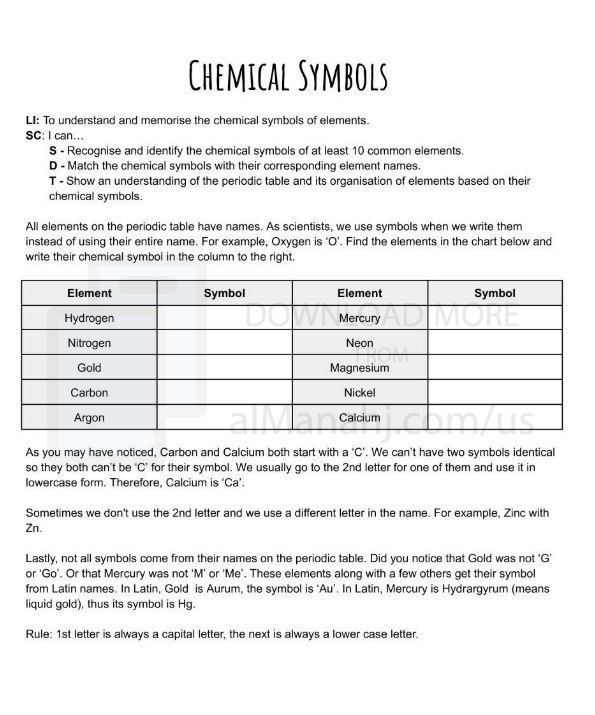| You are here: Almanahj Website ⇒ American curriculum ⇒ 10th Grade ⇒ Chemistry ⇒ Term 1 | ||
|---|---|---|
Worksheet about Chemical Symbols | ||
|---|---|---|
| Subject: Chemistry | ||
| 10th Grade | ||
| Term 1 | ||
| Year: 2023/2024 | ||
| Size: 514.2KB | ||
| Number of clicks: 99 | ||
| Publish date:November 07, 2023 | ||
| Added by: Eman | ||
| Last download date: 2024-08-27 22:52:25 | ||
| Updated by: Eman9966 on 2023-11-07 07:43:10 | By: theodor Yasemin Kurt | |
File info: Chemical symbols are short abbreviations used to represent elements in chemistry. These symbols are derived from the name of the element, often using the first letter or the first letter and an additional letter(s) of the element's name. The use of chemical symbols allows for a concise and standardized way to represent elements in chemical formulas, equations, and other scientific notations. Here are some key points about chemical symbols:1. Elements and Atomic Numbers: Each chemical symbol represents a specific element. Elements are substances that consist of only one type of atom. Each element is assigned a unique atomic number, which corresponds to the number of protons in the nucleus of its atoms. 2. One- and Two-Letter Symbols: Most chemical symbols consist of one or two letters. The first letter is always capitalized, while the second letter, if present, is lowercase. For example, "H" represents hydrogen, "O" represents oxygen, and "Na" represents sodium. Some elements have symbols derived from their Latin names, such as "Fe" for iron (from ferrum) and "Cu" for copper (from cuprum). 3. Symbols Derived from Non-English Names: Some chemical symbols are derived from non-English names or alternative names for elements. For example, "W" represents tungsten (from the Swedish word "tung sten," meaning heavy stone) and "Au" represents gold (from the Latin word "aurum"). 4. Historical Origins: The symbols for elements have historical origins and may not always directly correspond to the element's English name. For example, the symbol "K" represents potassium (from the Latin name "kalium") and "Pb" represents lead (from the Latin name "plumbum"). 5. Transuranium Elements: Elements beyond atomic number 92, which is uranium, are called transuranium elements. These elements are artificially synthesized and typically have three-letter symbols derived from their atomic number. For example, "Uut" represents ununtrium (atomic number 113) and "Cn" represents copernicium (atomic number 112). 6. Periodic Table: The chemical symbols are organized on the periodic table of elements. The periodic table arranges elements in order of increasing atomic number and groups them based on their similar properties and electron configurations. Chemical symbols are essential in chemistry as they provide a standardized and convenient way to represent elements and simplify chemical notations. They are widely used in chemical formulas, equations, and other scientific contexts to convey information about the composition and properties of substances. | ||
| Downloading link Worksheet about Chemical Symbols |
|---|
|
1699342908.pdf
The file is being prepared for download
|
| File images |
|---|
 |